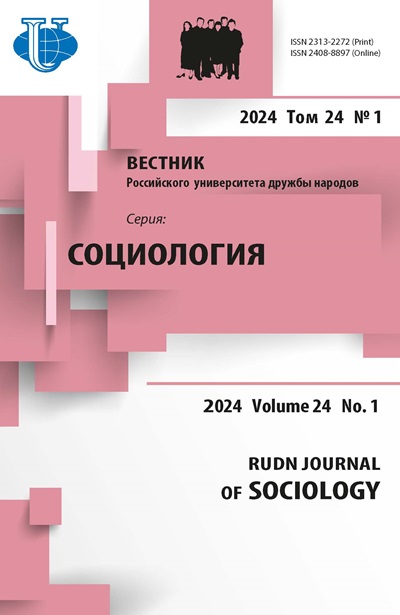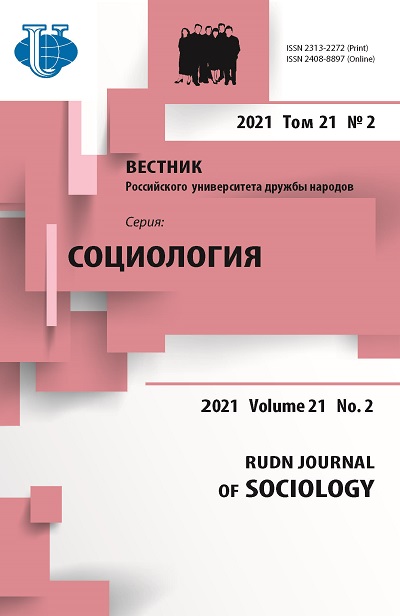Dynamics of labor migration in the Republic of Bashkortostan
- Authors: Akhmetova G.F.1
-
Affiliations:
- Institute for Strategic Studies of the Republic of Bashkortostan
- Issue: Vol 21, No 2 (2021)
- Pages: 265-278
- Section: Contemporary society: the urgent issues and prospects for development
- URL: https://journals.rudn.ru/sociology/article/view/26816
- DOI: https://doi.org/10.22363/2313-2272-2021-21-2-265-278
Cite item
Full Text
Abstract
The article considers some indicators of the widespread social phenomenon in Russia - labor migration, which, according to the data for 2019, involves about 2.9 million Russians, or 4% of the employed population. These are internal labor migrants who temporarily work outside their regions. This type of labor migration of Russians has common features with temporary employment in the United States, Canada, and Australia (long distance commuting - LDC), fly-in/fly-out - FIFO). The empirical basis of the article consists of the statistical data (results of the labor force survey by the Federal State Statistics Service for 2011-2019) and the results of sociological research conducted in the region with a high level of shift employment - the Republic of Bashkortostan - in 2015-2019. The statistical data prove regional differences in the Russian shift employment: the majority (72%) of internal labor migrants live in a third of the regions with high and medium levels of temporary labor migration; in some regions, the level of temporary labor migration decreases. The sociological data show different involvement in shift employment depending on place of residence, gender and age, marital status and level of education. The same social-territorial and social-demographic features are evident at the national level. At the federal level, internal labor migration, as a tool for social-economic development, helps to solve the problem of labor shortage in certain areas and sectors of economy; therefore, such labor migration is supported by legal acts. At the regional level, it decreases the labor and demographic potential of the regions that ‘provide’ labor migrants. To preserve the economic and demographic potential and to strengthen the competitiveness of such regions, we need to develop regional labor markets and labor mobility within regions.
Keywords
About the authors
G. F. Akhmetova
Institute for Strategic Studies of the Republic of Bashkortostan
Author for correspondence.
Email: hilazhevagf@isi-rb.ru
кандидат исторических наук, ведущий научный сотрудник
Kirov St., 15, Ufa, 450008, RussiaReferences
- Demograficheskie protsessy v Respublike Bashkortostan [Demographic Processes in the Republic of Bashkortostan]. Ufa; 2019. (In Russ.).
- Itogi vyborochnogo obsledovaniya rabochei sily [Results of the Sample Survey of the Labor Force]. 2019. URL: https://www.gks.ru/compendium/document/13265. (In Russ.).
- Karachurina L.B., Klimkin I.O., Andreeva E.A. Vahtovaya migratsija v jugo-vostochnom Bashkortostane [Shift migration in southeastern Bashkortostan]. Respublika Bashkortostan. Vyp. 4. Pod red. A.N. Degtyareva, A.R. Kuznetsovoy, G.F. Akhmetovoy. Ufa; 2020. (In Russ).
- Mezhdu domom i.. domom. Vozvratnaya prostranstvennaya mobilnost’ naseleniya Rossii [Between Home and.. Home. Return Spatial Mobility of the Russian Population]. Pod red. T.G. Nefedovoj, K.V. Averkievoj, A.G. Makhrovoj. Moscow; 2016. (In Russ.).
- Mkrtchyan N.V., Florinskaya Yu.F. Trudovaja prostranstvennaja mobilnost rossijan na primere zhitelej malyh gorodov [Labor Spatial Mobility of Russians on the Example of Residents of Small Cities]. Preprint. Moscow; 2015. (In Russ.).
- Mkrtchyan N.V., Florinskaya Yu.F. Zhiteli malyh i srednih gorodov Rossii: trudovaja migratsija kak alternativa bezvozvratnomu ot`ezdu [Residents of small and medium-sized cities of Russia: Labor migration as an alternative to irrevocable departure]. Zhurnal Novoy Ekonomicheskoy Assotsiatsii. 2019; 3. (In Russ.).
- O mezhregionalnoi trudovoi migratsii v 2019 godu [On Interregional Labor Migration in 2019]. URL: https://rosstat.gov.ru/storage/mediabank/GhpJyhEX/mtm_2019.pdf. (In Russ.).
- Nuikina E.V. Vlijanie vakhtovogo metoda raboty na prinimajushhie goroda rossijskogo severa (na primere goroda Vorkuty) [Influence of shift work on the host cities of the Russian North (on the example of the city of Vorkuta)]. Izvestiya Komi Nauchnogo Tsentra UrO RAN. 2013; 2. (In Russ.).
- Plyusnin Yu.M. Rossijskoe othodnichestvo: vekhi mnogovekovoj istorii [Russian seasonal workers: Milestones of the centuries-old history]. ECO. 2019; 11. (In Russ.).
- Plusnin Yu.M., Zausaeva Ya.D., Zhidkevich N.N., Pozanenko A.A. Otkhodniki [Seasonal Workers]. Moscow; 2013. (In Russ.).
- Trudovoi kodeks Rossiiskoi Federatsii (red. ot 31.07.2020 g.). Gl. 47. Osobennosti regulirovaniya truda lits, rabotayushchikh vakhtovym metodom [Labour Code of the Russian Federation (as amended from July 31, 2020). Ch. 47. Features of Regulation of Labor of Shift Workers]. URL: http://www.consultant.ru/document/cons_doc_LAW_ 34683/b28df2870d3 c3b2aeb65f905c59c7ddc1b139dd0. (In Russ.).
- Trudovaya migratsiya zhitelei Respubliki Bashkortostan v 2019 godu [Labor Migration of Residents of the Republic of Bashkortostan in 2019]. Ufa; 2020. (In Russ.).
- Turakaev M.S. Sociokulturnye faktory vosproizvodstva mobilnoj trudovoj zanjatosti v rossijskom regione (na primere severo-vostoka Respubliki Bashkortostan) [Social-cultural factors of the labor mobility reproduction in the Russian region (on the example of the North-East of the Republic of Bashkortostan)]. Avtoref. diss. k.s.n. Saint Petersburg; 2016. (In Russ.).
- Florinskaya Yu.F., Mkrtchyan N.V., Maleva T.M., Kirillova M.K. Migratsija i rynok truda [Migration and Labor Market]. Moscow; 2015. (In Russ.).
- Gallegos D. Airplanes Always Come Back’: Fly-in Fly-out Employment: Managing the Parenting Transitions. Perth; 2005.
- Hoath A., McKenzie H.F. The Socio-Economic Impacts of Long-Distance Commuting on Source Communities. Perth; 2013.
- Öfner E. In den Norden fernpendeln — Arbeitsmobilität im ruralen Baschkortostan. Doctoral thesis. Vienna; 2017
- Sibbel А Living FIFO: The Experiences and Psychosocial Well-Being of Western Australian Fly-in/Fly-out Employees and Partners. Edith Cowan University; 2010.
- Storey. K. Fly-in/fly-out: Implications for community. Sustainability. 2010; 2.
Supplementary files
There are no supplementary files to display.














